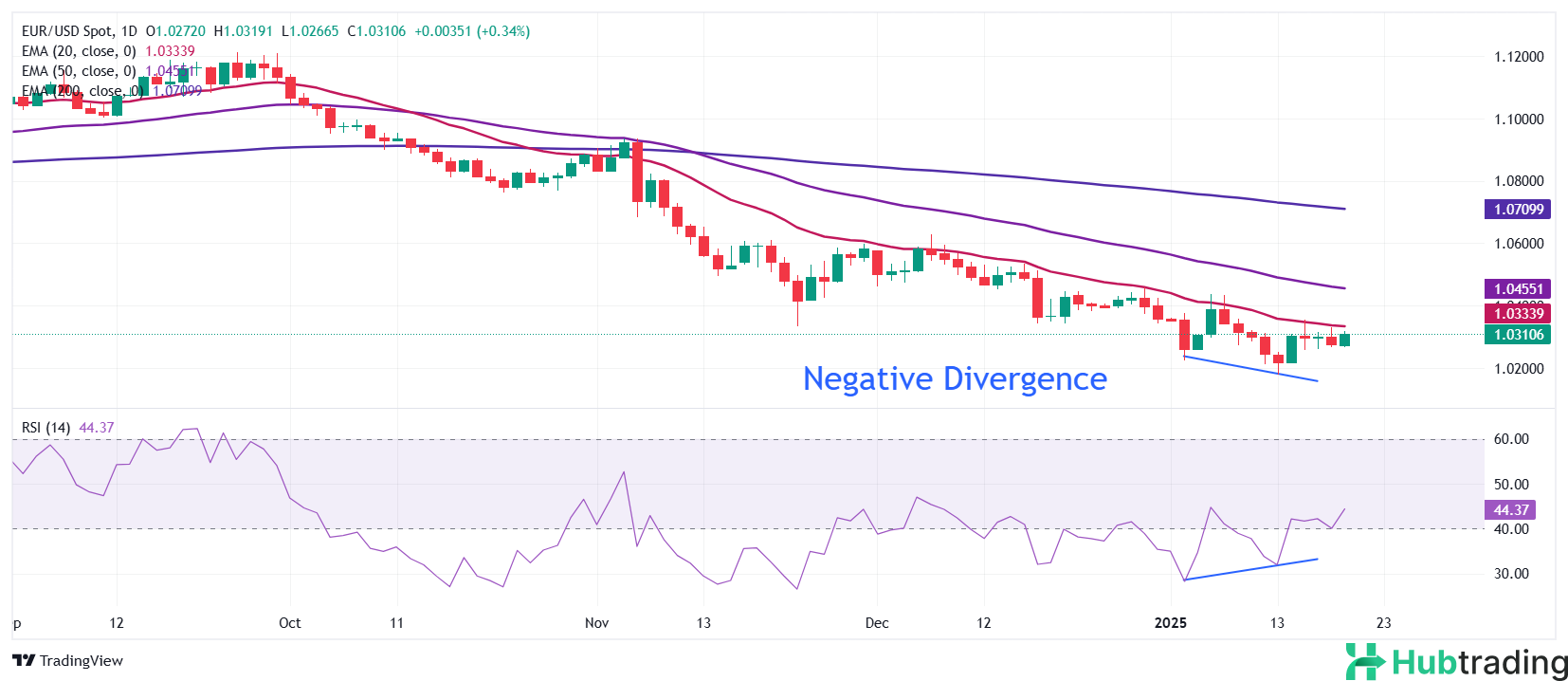- EUR/USD rebounds to near 1.0320 as risk sentiment improves ahead of Trump’s inauguration.
- The Federal Reserve is expected to hold interest rates steady through the May policy meeting.
- ECB’s Stournaras cautions that higher US tariffs could push Eurozone inflation below the central bank’s target.
EUR/USD climbs sharply to near 1.0320 during Monday’s European session, supported by diminishing safe-haven demand for the US Dollar (USD) ahead of President-elect Donald Trump’s inauguration. The US Dollar Index (DXY), which measures the Greenback against six major currencies, drops to around 109.00.
The USD faces pressure amid expectations that Trump may declare a national emergency after taking office, enabling increased domestic energy production and the rollback of climate change policies implemented under Joe Biden, according to Bloomberg. Additionally, Fox News Digital reports that Trump is set to sign over 200 executive orders on his first day, targeting policies like immigration controls, tax cuts, and higher import tariffs. While these measures are expected to stimulate US growth and inflation, they could also strengthen the Dollar in the longer term, allowing the Federal Reserve (Fed) to maintain its current interest rate range of 4.25%-4.50% for an extended period.
The CME FedWatch tool reflects market consensus that the Fed will hold rates steady through the next three policy meetings. However, Morgan Stanley analysts anticipate a potential rate cut in March, citing December’s deceleration in core inflation, which rose just 3.2% year-over-year, per the Consumer Price Index (CPI) report.
Daily Digest Market Movers: EUR/USD Climbs Ahead of Trump’s Inauguration
- EUR/USD rises amid risk-on sentiment as investors await Trump’s inauguration, though the Euro’s outlook remains clouded by expectations of multiple European Central Bank (ECB) rate cuts in upcoming meetings.
- Traders anticipate a total 100 basis point (bps) rate reduction by mid-summer, with a 25 bps cut expected at each of the next four ECB meetings. Dovish bets have intensified due to growing confidence that Eurozone inflation will return to the 2% target and concerns over potential U.S. tariff policies.
- Analysts at Capital Economics predict softer Eurozone inflation this year, citing the December uptick in service inflation to 4%—driven by oil-dependent sectors like transport and holiday packages—as temporary. They expect oil prices to follow historical trends and decline, which would ease inflationary pressures.
- ECB officials appear supportive of dovish expectations. On Friday, ECB policymaker and Bank of Greece Governor Yannis Stournaras called for a “series of rate cuts,” warning that U.S. protectionist measures could drive Eurozone inflation below the central bank’s target.
Technical Analysis: EUR/USD Consolidates Around 1.0300

EUR/USD rebounds to near 1.0320 at the start of the week, remaining range-bound around 1.0300 over the last four trading days after recovering from a two-year low of 1.0175 last week. The pair shows a divergence between momentum and price action, with the 14-day Relative Strength Index (RSI) forming a higher low near 35.00, while the pair marked lower lows.
Despite this rebound, the outlook remains bearish, as all short-to-long-term Exponential Moving Averages (EMAs) continue to slope downward.
On the downside, the January 13 low of 1.0175 serves as a critical support zone. Conversely, the January 6 high of 1.0437 is the key resistance level for Euro bulls.
(Note: This analysis was corrected on January 20 at 11:08 GMT to clarify that the pair has been trading sideways around 1.0300 for the last four trading days after recovering from a two-year low of 1.0175, not 1.175.)





